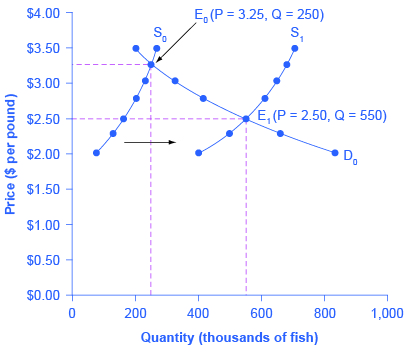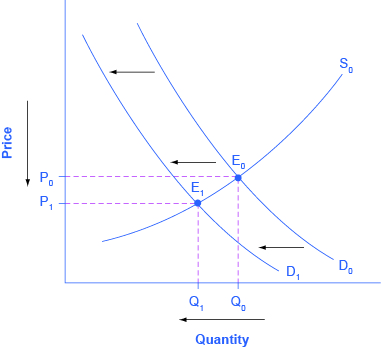Chapter 6 – Changes in Equilibrium Price and Quantity: The Four-Step Process
OpenStax
Learning Objectives
By the end of this section, you will be able to:
- Identify equilibrium price and quantity through the four-step process
- Graph equilibrium price and quantity
- Contrast shifts of demand or supply and movements along a demand or supply curve
- Graph demand and supply curves, including equilibrium price and quantity, based on real-world examples
Let’s begin this discussion with a single economic event. It might be an event that affects demand, like a change in income, population, tastes, prices of substitutes or complements, or expectations about future prices. It might be an event that affects supply, like a change in natural conditions, input prices, or technology, or government policies that affect production. How does this economic event affect equilibrium price and quantity? We will analyze this question using a four-step process.
Step 1. Draw a demand and supply model before the economic change took place. To establish the model requires four standard pieces of information: The law of demand, which tells us the slope of the demand curve; the law of supply, which gives us the slope of the supply curve; the shift variables for demand; and the shift variables for supply. From this model, find the initial equilibrium values for price and quantity.
Step 2. Decide whether the economic change being analyzed affects demand or supply. In other words, does the event refer to something in the list of demand factors or supply factors?
Step 3. Decide whether the effect on demand or supply causes the curve to shift to the right or to the left, and sketch the new demand or supply curve on the diagram. In other words, does the event increase or decrease the amount consumers want to buy or producers want to sell?
Step 4. Identify the new equilibrium and then compare the original equilibrium price and quantity to the new equilibrium price and quantity.
Let’s consider one example that involves a shift in supply and one that involves a shift in demand. Then we will consider an example where both supply and demand shift.
Good Weather for Salmon Fishing
In the summer of 2000, weather conditions were excellent for commercial salmon fishing off the California coast. Heavy rains meant higher than normal levels of water in the rivers, which helps the salmon to breed. Slightly cooler ocean temperatures stimulated the growth of plankton, the microscopic organisms at the bottom of the ocean food chain, providing everything in the ocean with a hearty food supply. The ocean stayed calm during fishing season, so commercial fishing operations did not lose many days to bad weather. How did these climate conditions affect the quantity and price of salmon? Figure 1 illustrates the four-step approach, which is explained below, to work through this problem. Table 7 provides the information to work the problem as well.

| Price per Pound | Quantity Supplied in 1999 | Quantity Supplied in 2000 | Quantity Demanded |
|---|---|---|---|
| $2.00 | 80 | 400 | 840 |
| $2.25 | 120 | 480 | 680 |
| $2.50 | 160 | 550 | 550 |
| $2.75 | 200 | 600 | 450 |
| $3.00 | 230 | 640 | 350 |
| $3.25 | 250 | 670 | 250 |
| $3.50 | 270 | 700 | 200 |
| Table 7. Salmon Fishing | |||
Step 1. Draw a demand and supply model to illustrate the market for salmon in the year before the good weather conditions began. The demand curve D0 and the supply curve S0 show that the original equilibrium price is $3.25 per pound and the original equilibrium quantity is 250,000 fish. (This price per pound is what commercial buyers pay at the fishing docks; what consumers pay at the grocery is higher.)
Step 2. Did the economic event affect supply or demand? Good weather is an example of a natural condition that affects supply.
Step 3. Was the effect on supply an increase or a decrease? Good weather is a change in natural conditions that increases the quantity supplied at any given price. The supply curve shifts to the right, moving from the original supply curve S0 to the new supply curve S1, which is shown in both the table and the figure.
Step 4. Compare the new equilibrium price and quantity to the original equilibrium. At the new equilibrium E1, the equilibrium price falls from $3.25 to $2.50, but the equilibrium quantity increases from 250,000 to 550,000 salmon. Notice that the equilibrium quantity demanded increased, even though the demand curve did not move.
In short, good weather conditions increased supply of the California commercial salmon. The result was a higher equilibrium quantity of salmon bought and sold in the market at a lower price.
Newspapers and the Internet
According to the Pew Research Center for People and the Press, more and more people, especially younger people, are getting their news from online and digital sources. The majority of U.S. adults now own smartphones or tablets, and most of those Americans say they use them in part to get the news. From 2004 to 2012, the share of Americans who reported getting their news from digital sources increased from 24% to 39%. How has this affected consumption of print news media, and radio and television news? Figure 2 and the text below illustrates using the four-step analysis to answer this question.

Step 1. Develop a demand and supply model to think about what the market looked like before the event. The demand curve D0 and the supply curve S0 show the original relationships. In this case, the analysis is performed without specific numbers on the price and quantity axis.
Step 2. Did the change described affect supply or demand? A change in tastes, from traditional news sources (print, radio, and television) to digital sources, caused a change in demand for the former.
Step 3. Was the effect on demand positive or negative? A shift to digital news sources will tend to mean a lower quantity demanded of traditional news sources at every given price, causing the demand curve for print and other traditional news sources to shift to the left, from D0 to D1.
Step 4. Compare the new equilibrium price and quantity to the original equilibrium price. The new equilibrium (E1) occurs at a lower quantity and a lower price than the original equilibrium (E0).
The decline in print news reading predates 2004. Print newspaper circulation peaked in 1973 and has declined since then due to competition from television and radio news. In 1991, 55% of Americans indicated they got their news from print sources, while only 29% did so in 2012. Radio news has followed a similar path in recent decades, with the share of Americans getting their news from radio declining from 54% in 1991 to 33% in 2012. Television news has held its own over the last 15 years, with a market share staying in the mid to upper fifties. What does this suggest for the future, given that two-thirds of Americans under 30 years old say they do not get their news from television at all?
Key Concepts and Summary
When using the supply and demand framework to think about how an event will affect the equilibrium price and quantity, proceed through four steps: (1) sketch a supply and demand diagram to think about what the market looked like before the event; (2) decide whether the event will affect supply or demand; (3) decide whether the effect on supply or demand is negative or positive, and draw the appropriate shifted supply or demand curve; (4) compare the new equilibrium price and quantity to the original ones.
Self-Check Questions
- Let’s think about the market for air travel. From August 2014 to January 2015, the price of jet fuel decreased roughly 47%. Using the four-step analysis, how do you think this fuel price decrease affected the equilibrium price and quantity of air travel?
- A tariff is a tax on imported goods. Suppose the U.S. government cuts the tariff on imported flat screen televisions. Using the four-step analysis, how do you think the tariff reduction will affect the equilibrium price and quantity of flat screen TVs?
References
Pew Research Center. “Pew Research: Center for the People & the Press.” http://www.people-press.org/.
Solutions
Answers to Self-Check Questions
-
Step 1. Draw the graph with the initial supply and demand curves. Label the initial equilibrium price and quantity.
Step 2. Did the economic event affect supply or demand? Jet fuel is a cost of producing air travel, so an increase in jet fuel price affects supply.
Step 3. An increase in the price of jet fuel caused a decrease in the cost of air travel. We show this as a downward or rightward shift in supply.
Step 4. A rightward shift in supply causes a movement down the demand curve, lowering the equilibrium price of air travel and increasing the equilibrium quantity.
-
Step 1. Draw the graph with the initial supply and demand curves. Label the initial equilibrium price and quantity.
Step 2. Did the economic event affect supply or demand? A tariff is treated like a cost of production, so this affects supply.
Step 3. A tariff reduction is equivalent to a decrease in the cost of production, which we can show as a rightward (or downward) shift in supply.
Step 4. A rightward shift in supply causes a movement down the demand curve, lowering the equilibrium price and raising the equilibrium quantity.

